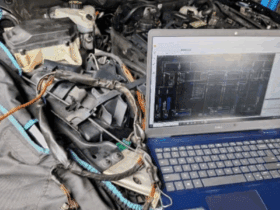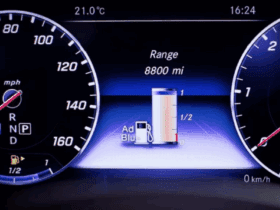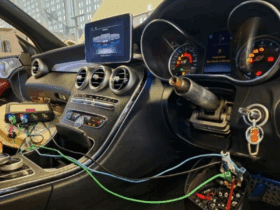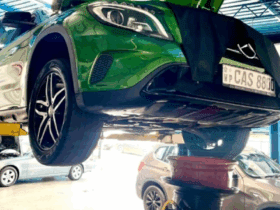Table of Contents
Mercedes Brake System Problems
The Mercedes brake system is a sophisticated network of hydraulic, electronic, and mechanical components working together to ensure optimal safety and performance. From ABS (Anti-lock Braking System) to ESP (Electronic Stability Program) and Active Brake Assist, each system plays a critical role in maintaining vehicle control.
However, even in luxury models, brake system problems can occur triggering dashboard warnings like “Brake Check”, “ESP Inoperative”, or “Active Brake Assist Functions Limited”. This guide brings together real workshop case studies and expert diagnostic insights to help you understand, diagnose, and fix Mercedes brake-related issues confidently.
Common Mercedes Brake System Issues
- – ABS Warning Light On : Usually caused by a faulty wheel speed sensor, corroded tone ring, or wiring fault.
- – ESP Inoperative / ESP See Owner’s Manual : Often triggered by a steering angle sensor error or poor wheel sensor signal.
- – Brake Pad Wear Message : Indicates worn brake pads or a broken brake wear sensor wire.
- – Brake Fluid Leak : Can occur from damaged brake hoses, loose fittings, or a faulty master cylinder.
- – Hard Brake Pedal : Typically linked to vacuum pump or brake booster issues.
- – Hissing Sound When Braking : A sign of air leaks around the brake booster or vacuum line.
- – Car Shaking Under Braking : Usually due to warped rotors or uneven pad wear.
- – Active Brake Assist Limited : Related to radar sensor blockage or calibration errors.
- – Parking Brake Malfunction : Caused by actuator faults, low voltage, or corrosion on rear brake calipers.
Symptom, Cause & Fix Table
| Symptom | Possible Cause | Recommended Fix |
|---|---|---|
| ABS light stays on | Faulty wheel speed sensor | Replace defective sensor and clear fault codes |
| ESP inoperative message | Steering angle sensor out of calibration | Recalibrate sensor with XENTRY or replace if faulty |
| Brake warning light | Low brake fluid or worn pads | Top up fluid and inspect pad thickness |
| Hard brake pedal | Vacuum leak or faulty booster | Test vacuum supply and replace booster if necessary |
| Hissing noise when braking | Air leak at brake booster hose | Replace damaged hose or O-ring |
| Car pulls while braking | Uneven pad wear or seized caliper | Service calipers, replace pads and rotors |
| Active Brake Assist limited | Dirty or misaligned radar sensor | Clean or realign sensor, recalibrate system |
| Parking brake see owner’s manual | Faulty actuator or low system voltage | Test motor actuator and battery voltage |
| Car shakes when braking | Warped brake discs | Replace discs and inspect hub alignment |
Diagnostic Process Overview
Diagnosing Mercedes brake system faults requires a structured approach using OEM tools like XENTRY or STAR Diagnosis:
- 1. Perform a Short Test : Scan all control units for stored and current fault codes.
- 2. Check Actual Values : Inspect live data from ABS, ESP, and SBC (if equipped).
- 3. Sensor Verification : Use the oscilloscope or diagnostic scanner to confirm proper wheel speed signals.
- 4. Hydraulic Inspection : Check for fluid leaks, line pressure, and vacuum levels.
- 5. Component Test : Activate ABS pump or ESP solenoids via actuation test.
- 6. Visual & Physical Inspection : Check brake pad thickness, rotor surface, wiring, and connectors.
- 7. Road Test & Recheck : After repairs, perform an on-road verification and system reinitialization.
Case Studies Grouped by Subtopic
Brake Warning & Wear Indicators
– Yellow Brake Warning Light: Causes, Fix & Safety Tips : Learn what the yellow brake warning light means and how to fix it safely.
– Brake Check: Diagnosis & Solutions : Step-by-step diagnosis for “Brake Check” message on the dashboard.
– Check Brake Pad Wear Alert: Fix It Fast : Find out how to reset and fix brake wear sensor issues.
– Brake Pad Thickness: What’s Safe & What’s Not : Guide to measuring and replacing worn brake pads before it’s too late.

Brake Performance & Feel
– Hard Brake: Solve the Hard Pedal Problem : How to diagnose a stiff brake pedal linked to vacuum or booster failure.
– Hissing Sound When Braking: Causes, Diagnosis & Fix : Detect air leaks in the brake booster or vacuum line.
– Car Shaking Under Braking: Diagnosis & Fix Guide : Identify warped rotors or seized calipers behind vibration issues.
– Brake Fluid Leak: Case Study & Quick Fix Guide : Locate and repair fluid leaks in the hydraulic brake circuit.

Electronic Brake Systems (ABS, ESP & Assist)
– ABS Light On Car: Here’s What It Really Means : Understand ABS function, warning triggers, and real repair examples.
– How to Fix ‘ABS and ESP Inoperative’ Error: Solution 100% : Complete diagnosis for dual ABS/ESP malfunction codes.
– ESP in Mercedes-Benz: Meaning, Faults & Fixes : Breakdown of common ESP faults, from steering sensors to yaw sensors.
– ESP Inoperable Mercedes: Solve It Fast : Case study on resolving ESP inoperative message through recalibration.
– ESP Inoperative See Owners Manual: Fix Guide : Quick fixes and real workshop data for this common dashboard warning.
– Active Brake Assist Functions Limited Mercedes: Solution : Step-by-step process to fix radar-related Active Brake Assist faults.
– Active Brake Assist Functions Limited : Understanding the message, testing radar alignment, and restoring assist function.
– Learn how to diagnose and repair ESP Not Available faults in Mercedes vehicles, including wheel sensor checks and voltage tests.

Parking & Hydraulic Systems
– Parking Brake See Owners Manual Warning? Quick Fixes Inside : Diagnose and reset parking brake issues caused by low voltage or actuator faults.
– Braking System Warning Light: Fixes & Tips Inside : All-in-one guide to handle red brake system warnings safely.

Prevention & Maintenance Tips
- – Replace brake fluid every 2 years (DOT 4+ recommended by Mercedes).
- – Inspect brake pad wear and rotor condition every 15,000 km.
- – Keep the ABS sensors clean and wiring protected from corrosion.
- – Avoid spraying high-pressure water near wheel speed sensors.
- – Regularly check for vacuum leaks or unusual hissing from the brake booster.
- – Calibrate steering angle sensors after wheel alignment or suspension work.
- – Clean radar sensors and camera covers to maintain Active Brake Assist accuracy.
FAQs: Mercedes Brake System Problems
Q1: Why does my Mercedes show “Brake Check” on the dashboard?
This warning typically appears due to low brake fluid, worn pads, or a faulty wear sensor. Always inspect both the hydraulic and electrical systems.
Q2: Is it safe to drive with the ABS light on?
You can drive, but braking safety is compromised. ABS will not function during emergency braking, increasing the risk of skidding.
Q3: What does “Active Brake Assist Functions Limited” mean?
It indicates the radar sensor or control unit cannot accurately assess obstacles often due to dirt, misalignment, or electrical issues.
Q4: How often should I replace brake pads and rotors?
Pads typically last 30,000–60,000 km depending on driving style. Rotors may last two pad cycles if within minimum thickness specs.
Q5: Can I reset the ESP or ABS light myself?
No, always identify and fix the underlying issue first using XENTRY or an OEM-level scanner before clearing the fault codes.
Related Hub Links
– Mercedes No Start Issues: Causes, Fixes & Case Studies
– Mercedes Transmission Issues: Causes and Fixes
– Mercedes-Benz Suspension Issues : Symptoms, Causes & Fixes
– Mercedes Cooling System Problems Guide: Troubleshooting
– Mercedes AC and Climate Control Problems
Author Bio
Mercedes Expert is an automotive technical trainer and Mercedes-Benz diagnostics expert with extensive hands-on experience in XENTRY, DTS Monaco, and advanced system troubleshooting. He specializes in transforming real workshop case studies into structured learning content to help technicians, car owners, and enthusiasts understand complex vehicle systems.






Leave a Reply